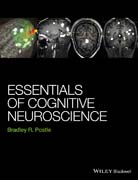
Essentials of Cognitive Neuroscience guides undergraduate students with no previous scientific background through the fundamental principles and themes in a concise, organized, and engaging manner. It is designed to provide students with a foundation to understand primary literature, recognize current controversies in the field, and engage in discussions on cognitive neuroscience and its future.Presented in full color, it contains a range of pedagogical features to aid student learning and understanding. Unique to this text, important experimental methods and techniques are introduced in individual Methodology boxes throughout the text, tying them explicitly to the scientific questions that motivate their use. The text is accompanied by a robust website with resources for students and instructors, including a 3–D interactive brain model, multiple choice and essay questions, PowerPoint slides, learning objectives, flashcards, web resources, experiment videos, fMRI data, and innovative video narratives in which key points from each chapter are explained by experts in these areas of research.Providing fundamental knowledge without an avalanche of overwhelming data, this textbook prepares students to understand and discuss the dynamic field of cognitive neuroscience in the 21st century. INDICE: Introduction to Section I: The neurobiology of thinking1 Introduction and HistoryKey ThemesA brief (and selective) historyWhat is a brain and what does it do?Looking ahead to the development of cognitive neuroscienceEnd–of–Chapter questionsReferencesFurther Reading2 The BrainKey ThemesPep talkGross anatomyThe neuronOscillatory fluctuations in the membrane potentialComplicated and complexEnd–of–Chapter questionsReferencesFurther ReadingIntroduction to Section II: Sensation, Perception, Attention, and Action3 Sensation and perception of visual signalsKey ThemesThe dominant sense in primatesOrganization of the Visual SystemInformation processing in primary visual cortex bottom–up feature detectionInformation processing in primary visual cortex interactivityWhere does sensation end? Where does perception begin?End–of–Chapter questionsReferencesFurther Reading4 Audition and somatosensationKey ThemesApologiaAuditionAdieu to sensationEnd–of–Chapter questionsReferencesFurther reading5 The visual systemKey ThemesFamiliar principles and processes, applied to higher–level representationsTwo parallel pathwaysThe organization and functions of the ventral visual processing streamTaking StockEnd–of–Chapter questionsReferencesFurther reading6 Spatial cognition and attentionKey ThemesUnilateral neglect: a fertile source of models of spatial cognition and attentionThe functional anatomy of the dorsal streamFrom parietal space to medial–temporal placeThe neurophysiology of sensory attentionTurning our attention to the futureEnd–of–Chapter questionsReferencesFurther reading7 Skeletomotor controlKey ThemesThe organization of the motor systemFunctional principles of motor controlMotor control outside of motor cortexCognitive functions of the motor systemIt s all about actionEnd–of–Chapter questionsReferencesFurther reading8 Oculomotor control and the control of attentionKey ThemesAttention and actionWhys and hows of eye movementsThe organization of the oculomotor systemThe control of eye movements, and of attention, in humansThe control of attention via the oculomotor systemAre oculomotor control and attentional control really the same thing ?Of labels and mechanismsReferencesFurther readingIntroduction to Section III: Mental Representation9 Visual object recognition and knowledgeKey ThemesVisual agnosiaComputational models of visual object recognitionCategory specificity in the ventral stream?To concludeEnd–of–Chapter questionsReferencesFurther reading10 Neural bases of memoryKey ThemesPlasticity, Learning, and MemoryThe case of H.M.Association through synaptic modificationHow might the hippocampus work? Memory systems To consolidateEnd–of–Chapter questionsReferencesFurther reading11 Declarative long–term memoryKey ThemesThe cognitive neuroscience of LTMEncodingThe hippocampus in spatial memory expertsRetrievalKnowledgeEnd–of–Chapter questionsReferencesFurther reading12 Semantic long–term memoryKey ThemesKnowledge in the brainDefinitions and basic factsCategory–specific deficits following brain damageThe neuroimaging of knowledgeThe progressive loss of knowledgePrimary Progressive Aphasia or Semantic Dementia, what s in a name?Nuance and challengesEnd–of–Chapter QuestionsReferencesFurther reading13 Short–term and working memoryKey Themes Prolonged Perception or Activated LTM? DefinitionsElevated, sustained activityA brave new world of multivariate data analysisThree–quarters of a centuryEnd–of–Chapter QuestionsReferencesFurther readingIntroduction to Section IV: High–Level Cognition14 Cognitive ControlKey ThemesThe lateral frontal–lobe syndromeModels of cognitive controlNeural activity relating to cognitive controlWhere is the controller?End–of–Chapter questionsReferencesFurther reading15 Decision makingKey ThemesBetween perception and actionValue–based decision makingForagingI can t decide!Next stopEnd–of–Chapter questionsReferencesFurther reading16 Social behaviorKey ThemesTrustworthiness: a preambleThe role of vmPFC in the control social cognitionTheory of MindObservational learningTrustworthiness, revisitedEnd–of–Chapter questionsReferencesFurther reading17 EmotionKey ThemesEmotion processing and mental healthTrustworthiness revisited –– againThe amygdalaWhat is an emotion?The control of emotionsThe amygdala as affective hubEnd–of–Chapter questionsReferencesFurther reading18 LanguageKey ThemesWernicke–Lichtheim: The classical core language networkSpeech perceptionGrammarSpeech productionAll together now Arousing novel ideas and subtle perceptions and judgments with the written wordEnd–of–Chapter questionsReferencesFurther reading19 ConsciousnessKey ThemesDifferent approaches to the problemThe physiology of consciousnessBrain functions supporting conscious perceptionTheories of consciousnessUpdating the consciousness graphEnd–of–Chapter questionsReferencesFurther readingGlossaryIndex
- ISBN: 978-1-118-46806-7
- Editorial: Wiley–Blackwell
- Encuadernacion: Cartoné
- Páginas: 560
- Fecha Publicación: 13/02/2015
- Nº Volúmenes: 1
- Idioma: Inglés
- Inicio /
- /
